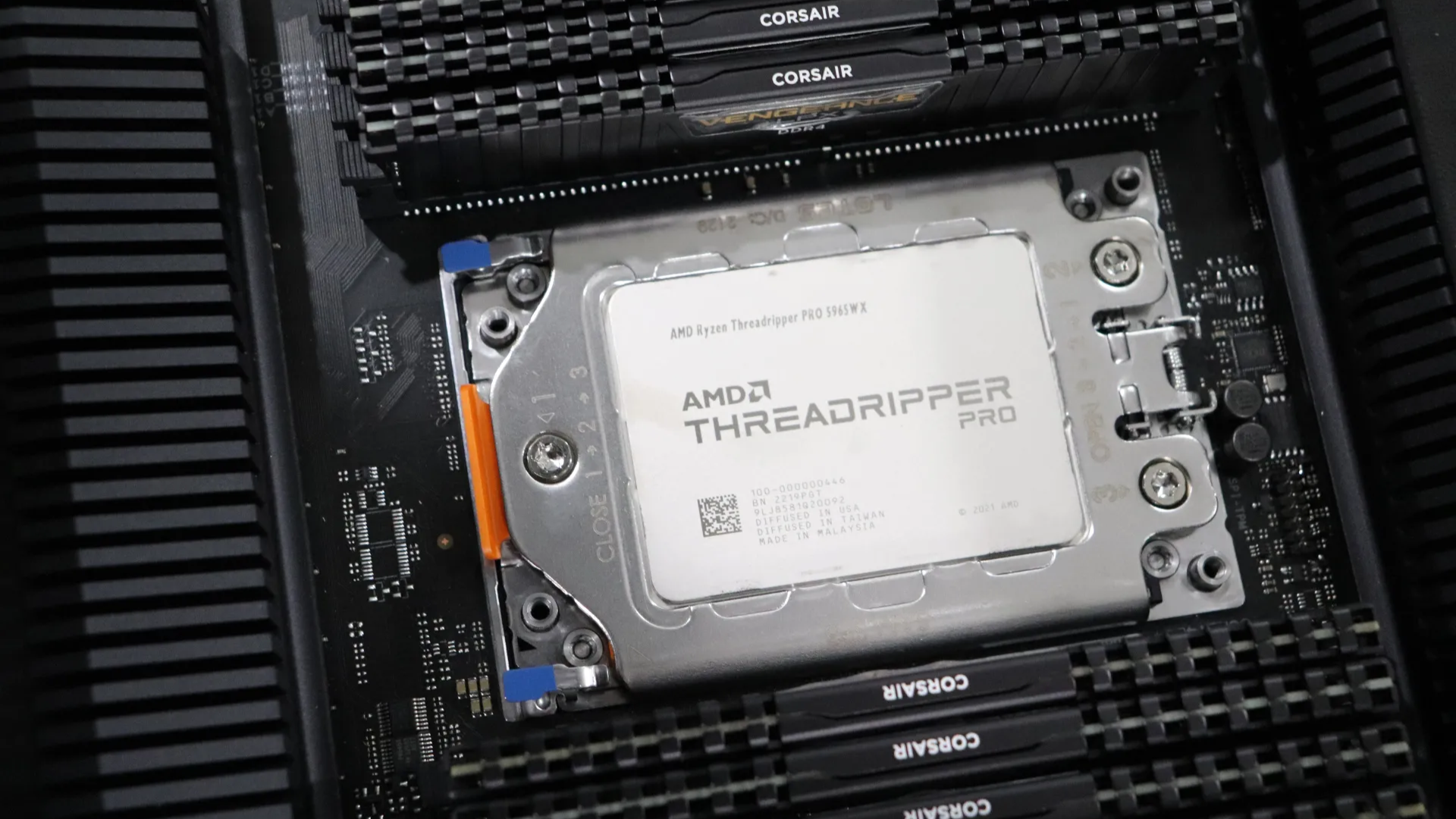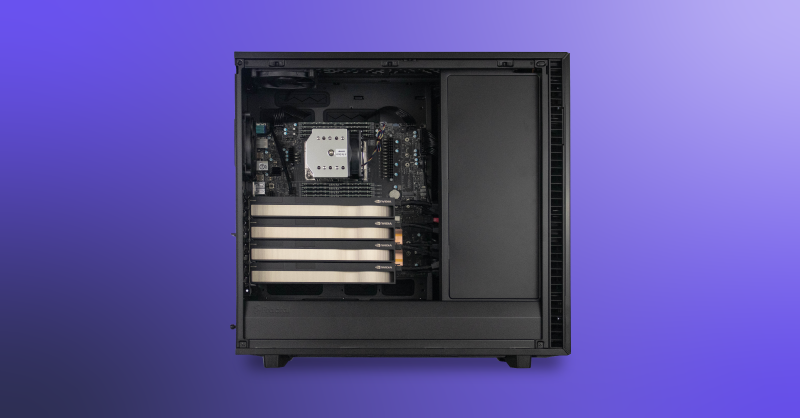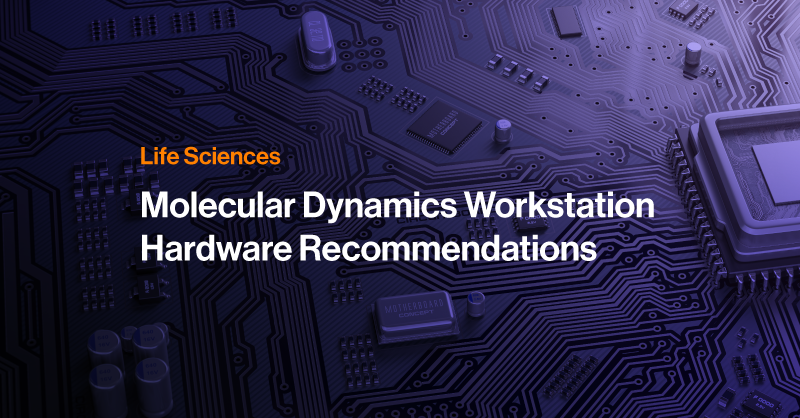Background on Molecular Dynamics
Molecular Dynamics (MD) simulations have become indispensable tools in scientific research, providing insights into the dynamic behavior of molecular systems. Whether unraveling the intricacies of biomolecules or exploring material properties at the atomic level, MD simulations have become a cornerstone in various fields.
SabrePC has delivered numerous purpose-built molecular dynamics system ranging from simple desktops to multi-GPU workstations and even 8 GPU servers. We’ve done this countless times and offer our expertise as a resource for you to build your dream system.
Popular MD Simulation software packages that we will go over include AMBER, GROMACS, and NAMD, all extremely popular software packages. The importance of considering all MD simulation packages despite their different hardware requirements is the potential that they may be used side by side.
The computational demands of MD simulations are substantial, necessitating a careful selection of hardware to ensure optimal performance. This blog aims to guide researchers and practitioners, and even students of the field, the realm of molecular dynamics by providing essential recommendations for building or upgrading a dedicated MD workstation or server.
Best CPU for Molecular Dynamics
Great all-around CPUs for MD simulation include the Intel Xeon W-3400 CPUs and AMD Threadripper PRO. We feel any processors with 32 to 64 cores will be sufficient and optimal for most workloads. This of course is dependent on other hardware in the system. Stick with single CPU deployments as the communication latency in a dual CPU server can slightly decrease speeds.
With 32 to 64 cores in mind, for Molecular Dynamics workloads, the main factor in choosing the right CPU is to prioritize the processor clock speeds over the cores count. While ample cores are no doubt important, the speed of the processor represents the instructions per clock a CPU delivers to other components of the system. If you choose a processor with too many cores (like the newest 96-core Threadripper PRO 7995WX), some of those cores can be left unutilized.

Most molecular dynamics software is more GPU dependent for performing the complex math calculations in MD simulation workloads. For that reason, we would recommend not overspending on a flagship CPU from AMD EPYC or Intel Xeon Scalable and opt for something middle of the line with higher base and boost clock speeds. Snag a top tier consumer CPU (AMD Ryzen or Intel Core) or a mid-tier 32 to 64 core workstation CPU from the AMD Threadripper PRO or Intel Xeon W-3400 line. Last generation AMD Threadripper PRO 5995WX (pictured above) is a great choice. If your workload requires more cores like in NAMD and GROMACS, you can also opt for a dual CPU setup with very fast cores. Dual CPU configurations are only available from the data center line of CPUs like AMD EPYC and Intel Xeon Scalable.
The main difference between a top tier consumer CPU and a mid-tier workstation CPUs and data center CPUs is the RAM capacity and the PCIe lanes. If your budget permits, opting for a workstation CPU can mean more memory and option for up 4x GPUs for maximum performance or accelerators for multiple jobs. A good rule of thumb would be to choose a CPU with the highest clock speed, and one that will satisfy the number of GPUs you want to use. While a consumer CPU platform may have 4 PCIe slots, keep in mind that only one or two of the slots will have the full x16 lanes with the others running x8. On the other side of the spectrum, opting for a two data center CPUs can yield twice the number of PCIe lanes for up to 8x GPUs.
All these considerations and factors can get jumbled up and hard to track. But at SabrePC we custom configure the system for you! Tell us your workload, hardware preferences, and goals and we will deliver you your dream system that works right out of the box.
Best GPU for Molecular Dynamics
The most popular GPUs for molecular dynamics are high-end GeForce RTX GPUs and mid-tier NVIDIA professional RTX GPUs. For the best GPUs for Molecular Dynamics, consider the RTX 4090 and 4080 and the RTX 6000 Ada, RTX 5000 Ada, and RTX 4500 Ada GPUs. Multi-GPU setups are extremely popular for scaling performance or running jobs in parallel. We will go over the reasons for these picks.
GPUs are the main reason for the uptick in high performance computing for molecular dynamics. AMBER, GROMACS, NAMD, and others leveraging the high parallel computing found in GPUs for crunching the complex calculations in molecular simulation workloads. But you knew that already! So, let's discuss what makes our GPU recommendations a great choice for these workloads.

Best GPU for AMBER
In AMBER, GPU core count and clock speeds also are the main priority with memory size not being a big factor. AMBER workloads don’t scale better with more GPUs. Instead, with a multi-GPU system, separate jobs can be run simultaneously for more throughput.
The RTX 6000 Ada is a great GPU for running AMBER and is a top performer as expected with a higher core count and high memory. But the RTX 4090, with very close number of cores, higher clock speeds, and higher memory speeds and bandwidth can be a great cost alternative, especially since it is a consumer GPU and doesn’t suffer from the professional RTX markup.
It also good to note that CPUs are not used at all in AMBER, with all calculations executed on the GPU. Therefore, if your system is strictly AMBER, prioritize your budget to having a stellar GPU with a CPU with at least 2 cores/4 threads per GPU.
Best GPU for GROMACS
For GROMACS, GPU core count and clock speeds also are the main priority with memory size not being a big factor. Furthermore, GROMACS workloads also don’t scale better with more GPUs and often with a multi-GPU system, will be used to run multiple separate jobs simultaneously.
However, GROMACS does utilize the CPU. Here we would splurge the budget on both, perhaps a good CPU with multiple mid-range GPUs.
Best GPU for NAMD
For NAMD, GPU core count and clock speeds also are the main priority with memory size not being a big factor. NAMD workloads will scale with multiple GPUs with a better runtime when more GPUs are involved.
For this reason, you will have to decide between one (or possibly two) RTX 4090s or outfitting a workstation or server with 4x RTX 6000 Ada GPUs for peak performance. For this reason, we would suggest going with a quad GPU setup with a mid-range professional RTX GPU such as the RTX 5000/4500 Ada GPU.
Because NAMD is also CPU reliant and since multiple GPUs increase speeds, opt for a good workstation CPU with good clock speeds and has the PCIe lane capacity for 4 GPUs.
Multi-GPU Setups for AMBER, GROMACS, NAMD
The only downside to using 4090s is the space within a workstation as mentioned above. Most workstations can comfortably fit one RTX 4090, whereas the RTX 6000 Ada has a smaller, standardized double-wide footprint. For any of the NVIDIA professional RTX GPUs, these cards can be stacked back-to-back to up to 4x GPUs in a single workstation.
This is where we would say, if you really want to have a multi-GPU setup, we recommend a mid-tier professional RTX GPUs like the RTX 5000 Ada or RTX 4500 Ada, both of which still have ample core counts but also cost significantly less per GPU due to the lower memory size as mentioned in the NAMD recommendations.
Now the last thing to consider is what software are you running as well. For AMBER and GROMACS, one or two RTX 4090s can be a great starting point, but if you want really strong parallel performance and running multiple jobs, as well as be able to run things like NAMD, or even cryo-EM workloads like RELION, opting for more GPUs and stacking more VRAM, a workstation with 4x GPUs or even a 4U server with 8x GPUs can greatly benefit your hardware’s diversity in running a bunch of different workloads.
Memory/RAM Recommendations for Molecular Dynamics
For most simulation type workloads whether its molecular dynamics or mechanical stress testing, ample memory is always important to have, or you risk bottlenecking. Our recommendation would to be to populate all DIMM slots with at least 16GBs DIMMs, but more optimally 32GB DIMMs to handle larger workloads.
For a flagship consumer desktop with 4 DIMM slots, that would equate to 64GB or 128GB of RAM. For workstation or 2U server deployments with 8 DIMM slots, that would equate to 128GB to 256GB of RAM.
AMBER, GROMACS, and NAMD all are not super memory intensive but having enough memory to hold the simulation can greatly benefit the runtime of the molecular dynamics simulation.
Closing Thoughts
As a recap, for CPUs we recommend a 32 to 64 core Intel Xeon W-3400 or AMD Threadripper PRO workstation processor. Our GPU recommendations we would suggest one (or two) RTX 4090 for those looking to spend as little as possible for the best performance. If you want more parallel processing, 4x RTX 6000/5000/4500 Ada depending on budget and computing goals. And for our Memory Recommendations 64GBs to 256GB of RAM, more RAM for larger simulations.
Talking about CPU, GPU and Memory are the main components in building a system. You’ll still need an appropriate power supply, a well-equipped cooling solution, storage (which we recommend 2TB- 4TB of NVMe storage), and a good case to fit it all into.
But at SabrePC, when your purchase a custom system with us, we handle all those things for you so you can ensure the system you get in the mail is truly your dream system. All you need to do is plug it in and press the power button.
Want to spec a workstation or system with us? Explore our workstations and server platforms for various Life Science and Molecular Dynamics software packages, fill out a contact us form on the platform you like, or talk to us today!


